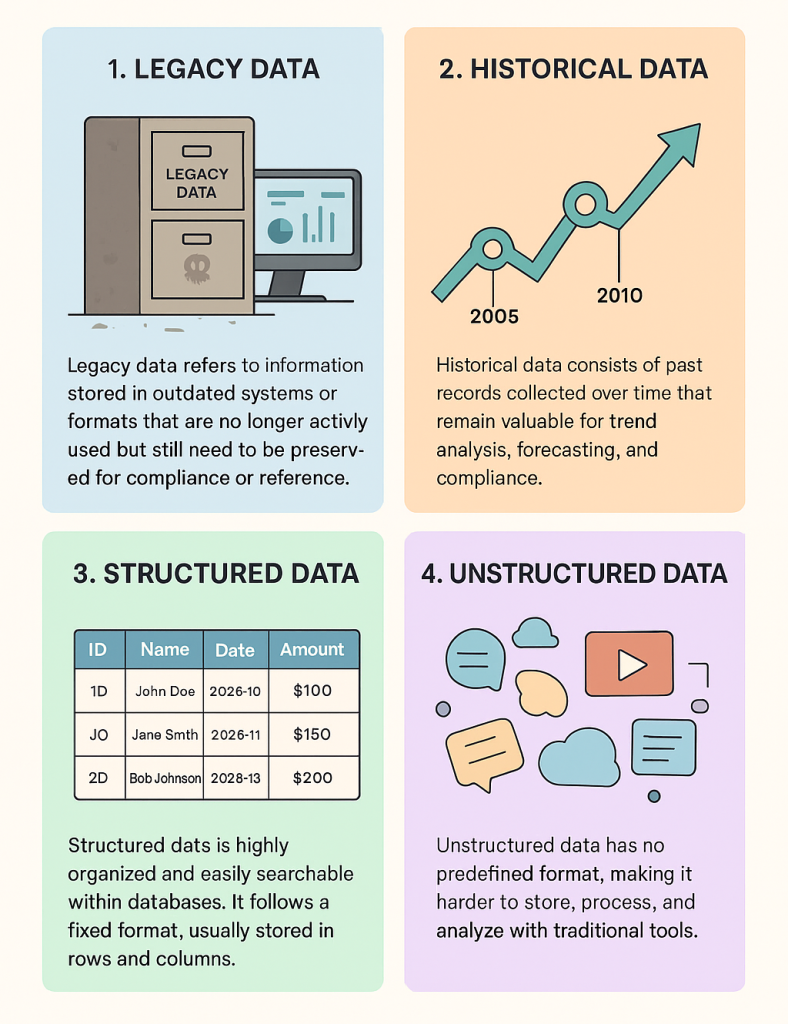In today’s digital landscape, data stands as one of the most valuable organizational assets. However, not all data is created equal. Companies gather and manage diverse kinds of data, each with its own role in driving decisions, ensuring compliance, and fostering innovation. Recognizing the distinctions between legacy, historical, structured, and unstructured data empowers organizations to build more effective data strategies and maximize value.
1. Legacy Data
Definition:
Legacy data is information stored in outdated systems or formats that are no longer in active use but must be retained for compliance or reference purposes.
Examples:
- Records on mainframe systems
- Old customer databases in obsolete file formats
- Archived documents on floppy disks or tape drives
Challenges:
- Difficult to access due to obsolete technology
- Costly to maintain
- Potential security vulnerabilities if poorly managed
Illustration : A cartoon archive room filled with dusty filing cabinets labeled “Legacy Data,” contrasted against a modern digital dashboard in the background.
2. Historical Data
Definition:
Historical data consists of records collected over time that retain value for trend analysis, forecasting, and compliance.
Examples:
- Sales data from the past decade
- Employee records from previous years
- Climate records used for weather models
Uses:
- Analyzing market trends
- Building predictive models
- Supporting compliance audits
Illustration : A timeline infographic plotting data points across years, demonstrating how historical data guides current and future actions.
3. Structured Data
Definition:
Structured data is highly organized, easily searchable, and typically stored in databases with fixed formats, such as rows and columns.
Examples:
- Financial transactions in spreadsheets
- Customer profiles in CRM systems
- Inventory records in relational databases
Advantages:
- Simple to query and analyze
- High reliability and accuracy
- Well-suited to traditional database technologies
Illustration : A neatly arranged table with rows and columns, showing how structured data fits seamlessly into databases.
4. Unstructured Data
Definition:
Unstructured data lacks a predefined format, making it more challenging to store, process, and analyze with standard tools.
Examples:
- Social media posts
- Emails, videos, and images
- Call center audio recordings
- IoT sensor logs
Challenges:
- Requires advanced technologies like AI and machine learning to extract insights
- Difficult to manage due to volume and variety
Illustration : A word cloud or a cluster of icons (videos, chat bubbles, images) capturing the vast, scattered nature of unstructured data.
Conclusion
Organizations today handle multiple types of data at once. While structured and historical data support reliable analysis and compliance, unstructured and legacy data present both hidden opportunities and potential risks. By understanding these data categories, businesses can develop stronger data governance, storage, and analytics strategies, ultimately transforming data into a strategic asset.
